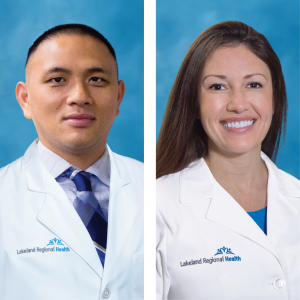
By TOAN NGUYEN, MD, and VANESSA PROWLER, MD
At Hollis Cancer Center, we are committed to providing you and your family with compassionate care centered on you and your needs. Certain questions seem to be on everyone’s minds, so we want to provide peace of mind by answering more commonly asked questions.
QUESTION: What are the signs and symptoms of breast cancer?
ANSWER: Early breast cancer usually does not cause any symptoms. This is why screening mammograms are extremely important in order to detect breast cancer at an early stage so treatment can be more effective. However, as breast cancer grows, a lump can sometimes be felt in the breast or even in the armpit. It may persist even after multiple menstrual cycles, which can help a woman differentiate it from lumpy breast tissue that often is more noticeable during a menstrual cycle.
QUESTION: What are the different types of breast cancer? Does one, in particular, carry a worse prognosis?
ANSWER: About 80% of breast cancer cases arise from the lining of the milk ducts. These are called invasive ductal carcinoma.
The second most common type of breast cancer, about 10% of cases diagnosed, is called invasive lobular carcinoma. There are other subtypes of breast cancer that makes up the remaining number of cases. Breast cancer also creates receptors on the cells called estrogen and progesterone receptors. The presence of these receptors allow anti-estrogen hormonal therapy to be given in the form of pills, making treatment more effective. Another receptor, called HER-2 neu, can be overly created in about 20% of breast cancer cases. The presence of these receptors allows us to give a drug called Herceptin and/or Perjeta, which makes breast cancer therapy extremely effective.
Some people have breast cancer that lacks the estrogen, progesterone, and HER-2 neu receptors. This type of cancer is called triple negative breast cancer and does tend to carry a less favorable overall prognosis. We have extremely effective treatment that allow a majority of women with triple negative breast cancer to live long, healthy lives.
QUESTION: What are the risk factors for breast cancer?
ANSWER: Known breast cancer risks factors are female gender, increasing age, Caucasian, earlier age at the first occurrence of menstruation, later age at first live birth, later age at menopause, and proliferative breast disease. Also, people with a positive family history of breast cancer are at higher risks.
QUESTION: For breast cancer survivors, should I be in a surveillance program?
ANSWER: The NCCN Guidelines recommends a history and physical exam 1-4 times per year for the first 5 years, then annually. A mammogram should be done annually. For patients on hormonal therapy, adherence to treatment should be encouraged. Evidence suggests an active lifestyle, a healthy body weight, limited alcohol intake, and a healthy diet may lead to optimal breast cancer outcomes.
QUESTION: What are the stages of breast cancer?
ANSWER: Breast cancer ranges from stage 0 to stage 4. Stage 0 is called DCIS, or ductal carcinoma in-situ.
QUESTION: When should a woman start her screening mammogram?
ANSWER: Average-risk women should start screening mammography at age 40. This is the recommendation from multiple prominent national medical societies, including the American College of Surgeons, the American Society of Breast Surgeons, and the American College of Radiology. Some guidelines have recommended starting at 45 or 50 even, but about 20% of patients will develop breast cancer prior to age 50 and early detection significantly improves outcomes.
About the Authors
Dr. Toan Nguyen and Dr. Vanessa Prowler are fellowship-trained Breast Surgeons at Lakeland Regional Health’s Hollis Cancer Center. To learn more or to make an appointment with Dr. Nguyen or Dr. Prowler, call 863.603.6565.
